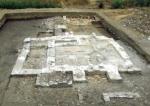Summary (English)
The excavations of 2008, located on the north-eastern side at the Roman colonial quarter in Vrina Plain, revealed a substantial stone structure that appear to have been a mausoleum. By the presence of ARS and Campanian amphorae of Dressel type 2-4 in the fill deposit (51) found in the entrance portico, the structure can be firmly dated to the early 3rd century AD. The mausoleum belongs to a later date than the adjacent bathhouse, and cuts the artificial layer used for levelling the walls of the bathhouse.
The mausoleum was rectangular in shape, with a doorway to the west and a small portico fronting the whole building. Two buttresses existed on both the northern and southern sides of the main building. At the eastern end of the principal chamber was a substantial stone foundation (50) probably intended for a large sarcophagus, which was no longer extant. Further graves were discovered to the north and south of the central passageway.
That to the north was a well-built cist tomb (34) with marble lining and a mortar ‘cushion’ at the head end. That to the south was again a stone platform for a missing sarcophagus (47, 48).
Two fragments of a Greek inscription were found during the excavation, probably originating from the tomb. The mausoleum and a cluster of associated graves may represent a family burial plot belonging to the owners of the adjacent villa.
The mausoleum carried on in use into the 5th century, though the pattern of burial seems to have changed somewhat. There are suggestions that the interior may have been refurbished, smaller cist tombs were built over the sarcophagus foundation (50) suggesting that it was no longer used, while other tombs were placed in the portico and between the buttresses on the exterior. Further free-standing masonry tombs were erected outside the building, to its south and seem reasonably clear that these were elements of a larger cemetery. Fallen walls and the stratigraphy indicate that the mausoleum collapsed or was demolished in the 5th or 6th century and after that the site was abandoned.
- Oliver Gilkes - ICAA-International Center for Albanian Archaeology / IWA-Institute of World Archaeology, University of East Anglia
Director
- Ilir Gjipali - Instituti i Arkeologjisë Tiranë, Departamenti i Prehistorisë (Albanian Institute of Archaeology, Department of Prehistory)
- Richard Hodges - ICAA-International Center for Albanian Archaeology / IWA-Institute of World Archaeology, University of East Anglia
Team
- Elis Grizhja
- Gjergj Vinjahu
- Valbona Hysa - QNASH - Qendra Ndërkombëtare për Arkeologjinë Shqiptare (ICAA- International Centre for Albanian Archaeology)
Research Body
- Instituti Arkeologjik Tiranë (Albanian Institute of Archaeology)
Funding Body
- Butrint Foundation
- Packard Humanities Institute






![Download [PDF]](/excavation/skins/fasti/images/results/download_sml.png)